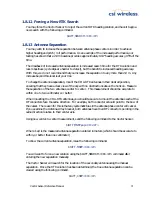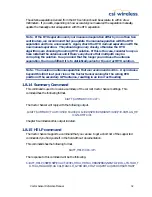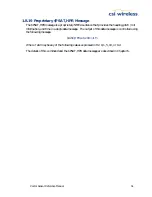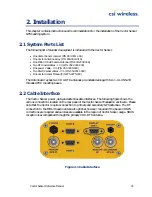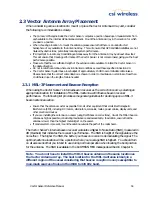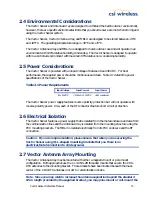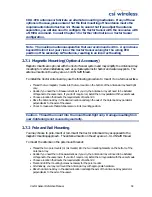
Vector Sensor Reference Manual
23
The magnetic sensor also can provide a secondary source of heading output in the event that a
GPS outage occurs due to signal obstruction.
Use of the magnetic aiding feature is now required, but, for shipping purposes, this feature is
disabled. In addition to reducing the time required to compute a heading solution, it can also
provide a secondary source of heading when a GPS heading is not available. When you are ready
to turn the magnetic aiding feature on, there are two different ways of calibrating. The magnetic
sensor must be calibrated after the completion of the installation process.
To turn the magnetic-aiding feature on, use the following command.
$JATT,MAGAID,YES<CR><LF>
You may turn this feature back off with the following command.
$JATT,MAGAID,NO<CR><LF>
To query the Vector for the current status of this feature, issue the following command.
$JATT,MAGAID<CR><LF>
1.8.4
Magnetometer Calibration
Metallic structures on the vessel affect a compass’ reading, so this effect must be ‘removed’
through the calibration process. Once the Vector is installed in its final location, to use this
feature, magnetic aiding must first be turned on, followed by its calibration. A valid GPS heading is
mandatory for the calibration process. There are two different ways to calibrate the
magnetometer.
The first way is to send a command to clear the current magnetic information to begin the
initialization process.
$JATT,MAGCLR<CR><LF>
Then, if you leave the unit powered continuously, it will automatically save the magnetic calibration
tables when the system has sufficiently sampled the magnetic field with numerous rotations.
Depending on this dynamics of your vessel, this may several days. For instance, if this system is
being used on a large cargo vessel that may only see significant rotation during harbor approaches
or maneuvers within a port or channel, this process may take many days. Thereafter, there is no
further calibration required. If you wish to check if the magnetic information has been saved, you
can issue the following command.
$JATT,MAGCAL<CR><LF>
The second method requires more work up front, but ensures your magnetic calibration
information is up to date and complete within a short period of time. A command to clear the
current magnetic information must first be sent to begin the initialization process, followed by
slowly rotating the vessel a full 360
°
approximately 3 to 10 times. Calibration should be
performed in a clear environment without any potential satellite blockages to minimize any possible
errors during the process. The command to initialize the magnetic calibration process follows.























